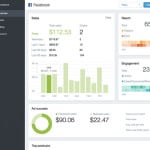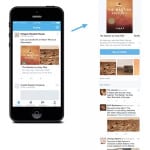eMarketer predicts that holiday retail sales in the US will reach $885.7 billion this year, a 5.7% year-over-year increase. Mobile will drive sales growth as consumers become more comfortable making purchases on smartphones and retailers improve the mobile shopping experience: m-commerce sales will increase an estimated 32.2%.
With time spent on mobile devices climbing, especially in social apps, marketers are striving to be where their customers are. As people purchase more via mobile, one-click buys are sure to drive significant revenue for retailers big and small. According to Business Insider, the U.S. ecommerce market grew 16% for the top 500 retailers in the country in 2014, with Facebook accounting for half of all retail referrals and 64% of total social-driven revenue.
Social media-driven traffic and sales are increasing faster than every other online channel. Facebook and Pinterest drive the most social referrals and revenue for retailers, without taking a commission (like in affiliate marketing). By reducing the friction between browsing and buying—and making the process trackable—“buy” buttons make social advertising more advantageous to retailers. Time will tell—will consumers fully embrace social commerce?
As of August 2015, 40.7% of US digital retailers had used a social buy button. Adoption will likely increase as brands test social commerce for the holiday season. Let’s review how buy buttons compare across Facebook, Instagram, Google, Twitter, and Pinterest.
Facebook’s Buy Call-to-Action Button
Facebook, which more than 1.01 billion people use every day, continues to pursue a full-funnel marketing strategy where users can gain information about brands and complete purchases. Over a year ago, the company began testing a “buy” button on News Feed ads and Pages that allows users to make purchases without ever leaving Facebook. Originally limited to a group of Shopify merchants, Facebook recently expanded the solution to a broader set of businesses.
Facebook has been methodically developing its advertising platform and forming partnerships to usher in a new era of one-click buying. Once people buy items directly on Facebook, they can opt to securely save payment information to make future purchases easier, even on mobile devices.
Facebook-owned Instagram hit 400 million users in September. The visual-focused platform has been a natural fit for retailers, but e-commerce initially posed a challenge. Since people couldn’t click through links in post captions, advertisers resorted to directing people to product descriptions with URLs to shopping pages.
Now, conversion is more seamless with Instagram’s direct response ad formats that debuted in June. Users can click a “Shop Now” button in sponsored posts and they’ll be taken to a retail site to make a transaction within Instagram.
Shoppable YouTube Videos
Google, whose YouTube property once dominated the video advertising market, has faced increased pressure from Facebook. Facebook’s user base, which is 50% larger than YouTube’s, consumes 8 billion videos each day. Now Google is competing with Facebook through “TrueView for shopping,” which allows consumers to click a retailer’s in-stream video ads on YouTube and go to a product page.
Whether this new ad format will increase online sales for retail partners remains to be seen, but initial results are promising. When testing the YouTube click-to-buy buttons, home goods retailer Wayfair “saw a 3X revenue increase per impression served compared to previous campaigns.”
Another new ad format from Google allows businesses to show click-to-buy ads in partner videos on YouTube. Users just have to click the “i” displayed at the top of the video to shop products.
Dedicated Product and Place Pages within Twitter
Twitter, with 320 million monthly active users, started experimenting with social commerce in September 2014 by launching its own “buy” button. Customers can save their payment information to enable one-click buying inside promoted tweets in the Twitter app or website.
More recently, Twitter introduced dedicated pages featuring users’ tweets about products, including a description, price, and link to website for additional info. If users like what others are saying, they have the option to purchase directly within Twitter.
Buyable Pins
In June, Pinterest released buyable Pins for iPhone and iPad users in the U.S. and recently started rolling them out to U.S. Pinners on Android. These Pins, distinguished by a blue “Buy it” button, appear in search results, the home feed, and boards.
Pinterest’s 100 million worldwide monthly users can filter items by price and color and save Pins for later if they aren’t ready to buy yet. Pinners can also gain inspiration through the Pinterest Shop which features items hand-picked by Pinterest. Pinners can click “Buy it” to pay within the app via credit card or Apple Pay and store their information to expedite their next purchase.
At the moment, buyable Pins are available from big retailers like Macy’s and Nordstrom plus businesses powered by five commerce platforms—DemandWare, Shopify, Bigcommerce, IBM Commerce, and Magento.
Missy Goss is a Marketing Manager with Adaptly.

